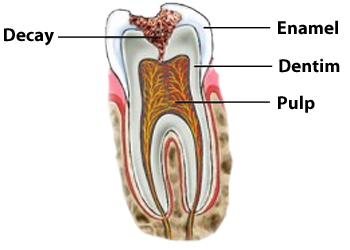Learning in the Partners In Dental Care Lobby
Back Forward
All About Fluoride
Fluoride is a naturally occurring mineral in water that can incorporate itself into our teeth to make them stronger through its resistance to bacteria and acids like those in soda pop. It can even reminineralize areas where the tooth is already weakened.
Research from the National Institutes of Health indicates that dramatic reductions in tooth decay (the most prevalent disease in children) are the result of increased use of fluoride water.
Fluoride is available to children in several ways, including topical fluoride (applied directly to teeth), mouth rinses like ACT, professional gels/foams/varnishes like those at our office, fluoridated water, supplements and more. Ask your dentist to learn more about how to protect your child's teeth with fluoride.
Learning in the Partners In Dental Care Lobby
Back Forward
Age-Appropriate Oral Hygiene
As they age, children need different levels of care to maintain their oral hygiene at home:
- 0–6 months—Wipe gums with a damp warm cloth at the end of each day before teeth appear.
- 6–28 months—Brush your child’s teeth with a soft bristled toothbrush using a pea-sized portion of non-fluoridated toothpaste, one to two times per day. Encourage good spitting habits to avoid swallowing toothpaste.
- 28 months – Adult—Help your child use a soft bristled toothbrush with pea-sized portion of fluoridated toothpaste. Brush two times per day using gentle circular motions (electric tooth brushes do an excellent job of this). Flossing should begin when there are at least two neighboring teeth that touch each other.
Talk to your dentist about other home treatments such as disclosing tablets, rinses and sealants.
Learning in the Partners In Dental Care Lobby
Back Forward
Preventing Tooth Decay
Tooth decay is caused by four culprits: sugar, acids, bacteria and bad oral hygiene. It occurs when destructive bacteria that live on teeth ingest sugars in our foods and secrete acids that break down tooth enamel. Once that happens, the bacteria are able to destroy a baby tooth within months.
Sugars and acids are commonly found in soda, gum, cookies, candy, juice, flavored waters and milk. Bad bacteria thrive in these acidic sugary environments, and even diet sodas, though they contain no sugar, are nearly as acidic as battery acid. Bacteria often hide in the grooves of teeth and near gums.
Appropriate oral hygiene and restricting consumption of juice and milk to meal times is important to keep destructive bacteria from resting on teeth. Check out the oral hygiene section of this app to learn more about how to protect your child’s teeth.
Learning in the Partners In Dental Care Lobby
Back Forward
About Thumb Sucking
Thumb sucking and the use of pacifiers is a natural transition for children who are used to clinging to their parents.
It’s not necessary to prevent children from doing this on the first occurrence; however, as your child approaches later stages of childhood, you will need to help them taper this habit and should stop altogether by the age of five. This is the age when adult teeth are forming and will soon erupt, and thumb sucking can seriously affect the shape of the mouth and the alignment of teeth.
Learning in the Partners In Dental Care Lobby
Back Forward
Stopping Bad Habits
Some of the best ways to help children stop thumb sucking are:
- Putting a band-aid on their thumb
- Painting something that tastes bad on their thumb
- Covering their hand with a sock
- Rewarding them on days where they do not indulge the habit
Ask us your dentist if you think thumb sucking or pacifier use is becoming a concern for your child.
Learning in the Partners In Dental Care Lobby
Back Forward
The Benefits of Xylitol
Xylitol is a naturally occurring substance that tastes like sugar. It is found naturally in many fruits and vegetables and is even produced by our bodies during normal metabolism.
Why it pertains to oral health—Research has shown that the bad bacteria in our mouths do not digest Xylitol like they digest regular sugar. If they don’t have sugar to feast on, then they cannot function at a high level and cause decay. Xylitol is also effective at reducing the acidity of our saliva after meals and drinking soda.
Where you can find it—Xylitol is commonly found in some “sugar free” chewing gums, candies, toothpastes, rinses and breath mints and drops. Chewing a piece of gum with Xylitol after a meal, snack or drink can really help your overall oral health without any of the bad side effects of sugar.


